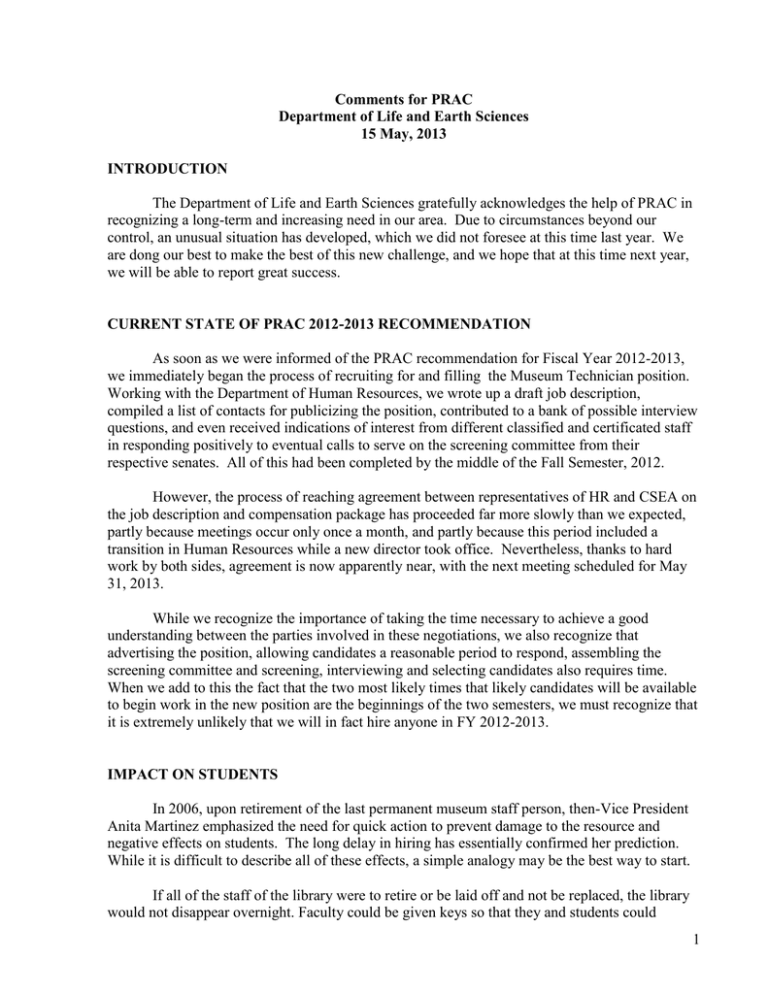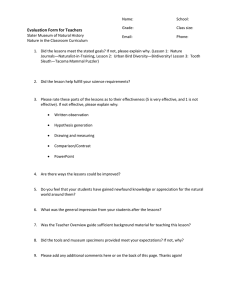The Department of Life and Earth Sciences gratefully acknowledges the... recognizing a long-term and increasing need in our area. ... Comments for PRAC
advertisement

Comments for PRAC Department of Life and Earth Sciences 15 May, 2013 INTRODUCTION The Department of Life and Earth Sciences gratefully acknowledges the help of PRAC in recognizing a long-term and increasing need in our area. Due to circumstances beyond our control, an unusual situation has developed, which we did not foresee at this time last year. We are dong our best to make the best of this new challenge, and we hope that at this time next year, we will be able to report great success. CURRENT STATE OF PRAC 2012-2013 RECOMMENDATION As soon as we were informed of the PRAC recommendation for Fiscal Year 2012-2013, we immediately began the process of recruiting for and filling the Museum Technician position. Working with the Department of Human Resources, we wrote up a draft job description, compiled a list of contacts for publicizing the position, contributed to a bank of possible interview questions, and even received indications of interest from different classified and certificated staff in responding positively to eventual calls to serve on the screening committee from their respective senates. All of this had been completed by the middle of the Fall Semester, 2012. However, the process of reaching agreement between representatives of HR and CSEA on the job description and compensation package has proceeded far more slowly than we expected, partly because meetings occur only once a month, and partly because this period included a transition in Human Resources while a new director took office. Nevertheless, thanks to hard work by both sides, agreement is now apparently near, with the next meeting scheduled for May 31, 2013. While we recognize the importance of taking the time necessary to achieve a good understanding between the parties involved in these negotiations, we also recognize that advertising the position, allowing candidates a reasonable period to respond, assembling the screening committee and screening, interviewing and selecting candidates also requires time. When we add to this the fact that the two most likely times that likely candidates will be available to begin work in the new position are the beginnings of the two semesters, we must recognize that it is extremely unlikely that we will in fact hire anyone in FY 2012-2013. IMPACT ON STUDENTS In 2006, upon retirement of the last permanent museum staff person, then-Vice President Anita Martinez emphasized the need for quick action to prevent damage to the resource and negative effects on students. The long delay in hiring has essentially confirmed her prediction. While it is difficult to describe all of these effects, a simple analogy may be the best way to start. If all of the staff of the library were to retire or be laid off and not be replaced, the library would not disappear overnight. Faculty could be given keys so that they and students could 1 retrieve especially-needed books for themselves or their students. Thus one would be able to say that students were being served and that the resource was still present on campus. Of course, the situation would be far from convenient for students or faculty. In addition, over time, the collection would become more and more disorganized, it would become more difficult to find specific books, and damage and deterioration would take their toll. An unstaffed library could also lead to safely problems. Essentially, this has been the situation with the museum, except that it has been worse. As Vice President Martinez noted seven years ago, the fact that a major move was being contemplated meant that preparations need to be made for the move. Inventory had to be conducted and moving plans based on the inventory and the spaces in the new and old buildings had to be prepared to minimize disruption caused by the move. COPING WITH THE IMMEDIATE SITUATION The Earth and Life Sciences Department has been very resourceful in coping with the challenges presented by this situation. A series of student hourly employees has made available some of the museum resources to students. Faculty have suggested off-campus museums where students can go to find resources previously available on our campus. Museum items that have become damaged and those that can no longer be found have been replaced with cards giving brief verbal descriptions of the items and sometimes references to further descriptions in textbooks. Cards have also replaced staff previously available to answer questions. Hours have been shortened, and all public exhibits have been cancelled. We no longer respond routinely to requests for visits from high school or other community groups. Through these changes, we have saved money and have managed to survive. RECOMMENDATIONS FOR FY 2013-2014 The Department recognizes the current financial difficulties of the college, yet it also recognizes that this is a key time for investment in the future. Many financial analysts noted that the start of the Great Recession in 2008, marked the beginning of great opportunities for investment. Of course, not all could and did take advantage of these opportunities; thus the rich got richer and the poor got poorer. Our department would like to help the college avoid getting poorer, in its finances, in its other resources, and in the services it provides to students. We want to make things better! We recommend that at least some of some of the savings realized from not hiring the museum technician in FY 2012-2013 be applied to increasing the FTE in FY 2013-14 and beyond. We have compiled the following outline of what different levels of investment in this position will produce in the future. 1. Fund the Position at 20 Hours per Week. This will slow the current trend of deterioration, but not stop it. There will at least be someone to be the interface between the collections and the students and faculty, and some specimens will be made available for courses. However, since ongoing disorganization and deterioration will not be addressed, the level 2 of service provided by the same number of hours will gradually decline. The person recruited for the position will also likely not consider this a long-term job option; this could produce further instability and costs in the future 2. Fund the Position at 30 Hours per Week. This could possibly halt the current trend of deterioration, since after meeting the immediate needs of students and faculty for specimens and exhibits for classes, important inventory and maintenance work could be undertaken. There might be some instability in the position, as we have seen with the Mathematics, Earth and Life Sciences and Physical Sciences Administrative Assistant, but it would likely be markedly less. We might at least return to the 2006 levels of maintenance and service. 3. Fund the Position at 40 Hours per Week. This would actually permit an increase in levels of service to students and to the campus community. It would permit exhibits open to non-science students and to the surrounding community. It would also permit an increase in fundraising and outreach. The recent Grand Opening of the new SMN building showed the potential that exists in these areas, yet this potential will not be realized without sustained and continuous work by knowledgeable staff. Since increased fundraising is an important long-term college goal, and since the museum is an important resource for fundraising, this would indeed be a strategic investment. 3


